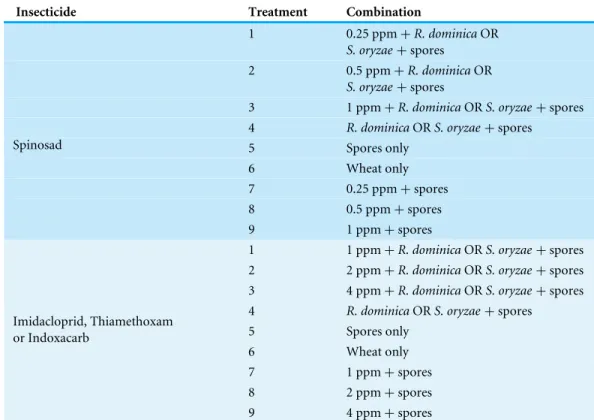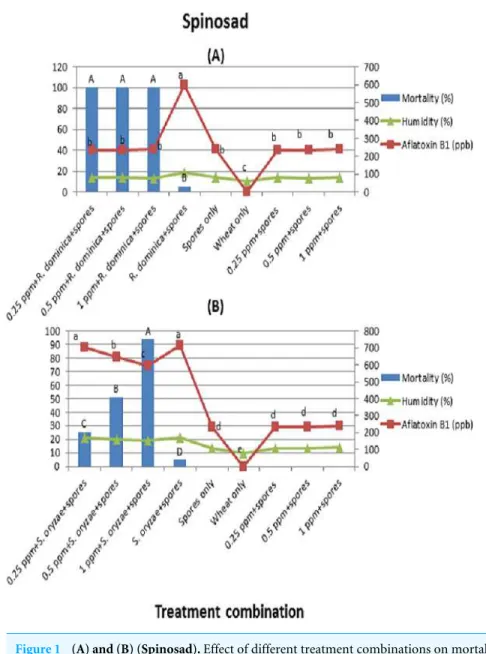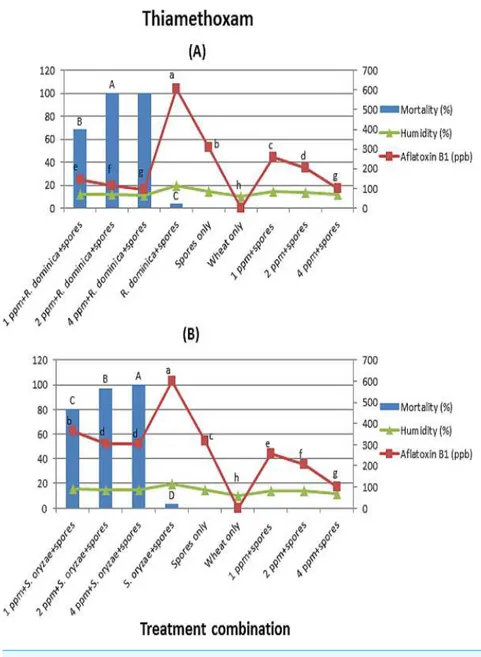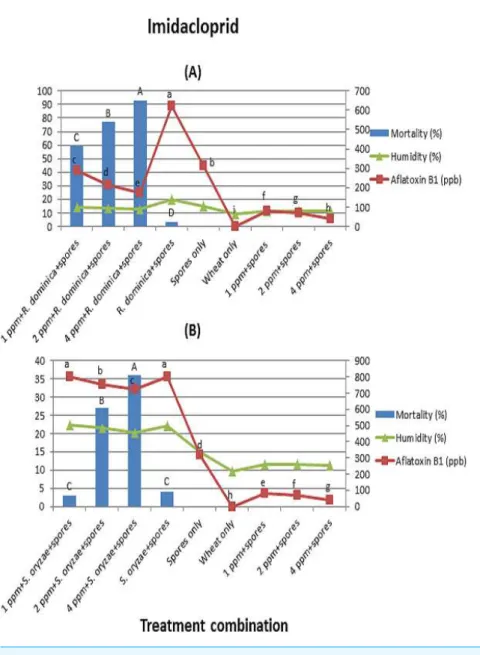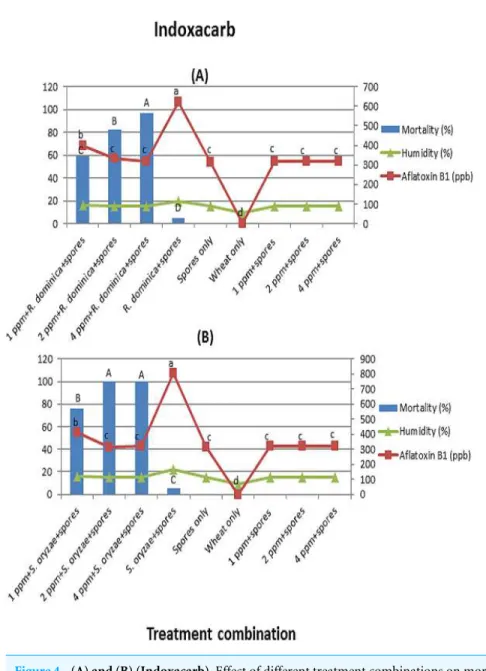Submitted24 May 2015 Accepted 16 January 2016 Published22 February 2016
Corresponding author Hafiz Azhar Ali Khan, azhar_naturalist@yahoo.com
Academic editor Leon Higley
Additional Information and Declarations can be found on page 11
DOI10.7717/peerj.1665
Copyright 2016 Khan et al.
Distributed under
Creative Commons CC-BY 4.0
OPEN ACCESS
Could biorational insecticides be used
in the management of aflatoxigenic
Aspergillus parasiticus
and its insect
vectors in stored wheat?
Tiyyabah Khan, Ahmad Ali Shahid and Hafiz Azhar Ali Khan
Faculty of Life Sciences, Institute of Agricultural Sciences, University of the Punjab, Lahore, Pakistan
ABSTRACT
Insect pests in stored wheat cause significant losses and play an important role in the dispersal of viable fungal spores of various species including aflatoxin producing
Aspergillus parasiticus. The problem of insecticide resistance in stored insects and environmental hazards associated with fumigants and conventional grain protectants underscore the need to explore reduced risk insecticides to control stored insects with the ultimate effect on aflatoxin production. The purpose of this study was to investigate the insecticidal potential of four biorational insecticides: spinosad, thiamethoxam, imidacloprid and indoxacarb, on wheat grains artificially infested withRhyzopertha dominica/Sitophilus oryzae and/or A. parasiticusspores, and the subsequent effect on aflatoxin production. Spinosad and thiamethoxam were the most effective insecti-cides againstR. dominicacompared toS. oryzae followed by imidacloprid. Spinosad applied at 0.25–1 ppm and thiamethoxam at 2 and 4 ppm concentrations resulted in complete mortality of R. dominica. However, indoxacarb was more toxic against
S. oryzaecompared toR. dominica. Wheat grains inoculated withR. dominica/S. oryzae
+spores elicited higher aflatoxin levels than wheat grains inoculated with or without insecticide+spores. In all the treatment combinations containing insects, aflatoxin production was dependent on insects’ survival rate. In addition, thiamethoxam and imidacloprid had also a significant direct effect on reducing aflatoxin production. Aflatoxin levels were lower in the treatment combinations with any concentration of thiamethoxam/imidacloprid+spores as compared to wheat grains inoculated with spores only. Correlation analyses revealed highly significant and positive association between moisture contents/insect survival rate and production of aflatoxin levels, and insect survival rate and moisture contents of the wheat grains. In conclusion, the results of the present study provide baseline data on the use of biorational insecticides against
R. dominicaandS. oryzaeand subsequent effect on aflatoxin production.
SubjectsAgricultural Science, Entomology, Mycology, Plant Science, Soil Science
Keywords Spinosad, Indoxacarb, Thiamethoxam, Imidacloprid, Stored insect pests, Aflatoxin, Mycotoxin,Tribolium,Rhyzopertha
INTRODUCTION
hepatotoxic, mutagenic and teratogenic (Patten, 1981), since they lead to serious human and animal health hazards, including acute and chronic liver diseases, tumor induction, reproductive disorders, genotoxicity and nephrotoxicity (Chao, Maxwell & Wong, 1991;
Lacey, 1988;Desjardins et al., 2000). These mycotoxins are also known to contaminate more than 25% of the world stored grain cereal commodities of which more than 300 fungal metabolites have been reported to cause human and animal toxicity (Galvano et al., 2001).
Stored grain contaminations with insect pests and fungi are a serious problem resulting in more than 20% losses in overall production by decreasing seed germination and downgrading of grains (Philip & Throne, 2010). Factors like the temperature and humidity at postharvest stages play an important role in insect pest infestations, growth of toxigenic fungi and aflatoxin production in storage ecosystems. Contamination of stored grains with fungal spores is mainly a source of mycotoxins which usually results from stored insect pest infestations (Birck, Lorini & Scussel, 2006). Insects disseminate the fungal spores all over the grain bulk by their constant movement, which are carried on their body and/or deposited in insect frass (Santos & Mantovani, 1997). These insects break the seed coat as a natural barrier to fungus and provide an entry point for fungal infection (Setamau et al., 1998) which ultimately results in mycotoxin production. Therefore, strategies to control insects are needed. The most serious insect pests of stored grains that cause >20% postharvest losses in developing countries are: rice weevil (Sitophilus oryzae), red flour beetle (Tribolium castaneum), lesser grain borer (Rhyzopertha dominica), rusty grain beetle (Cryptolestes ferrugineus) and khapra beetle (Trogoderma granarium) (Philip & Throne, 2010).
Control of these insects is of prime importance as they have the ability to carry and transmit spores of aflatoxigenic Aspergillusspp. internally (Barra, Nesci & Etcheverry, 2013). Current control measures for these insects rely on the extensive use of fumigants and conventional insecticides that have created some drawbacks like increased insect resistance (Gurusubramanian et al., 2008), primary pest resurgence (Hazarika, Bhuyan & Hararika, 2009), secondary pest outbreak (Cranham, 1996), and their use as grain protectants is being reconsidered for their effect on health and environmental safety (Vayias et al., 2010). Some of the conventional insecticides have also been reported to inhibit the production of aflatoxins in storage ecosystems. Dichlorvos (an organophosphate) was the first conventional insecticide reported to be effective in the inhibition of aflatoxin production in different stored commodities like corn, rice, wheat and peanuts (Rao & Hareim, 1972). Thereafter, insecticides from different classes like naled, pyrethrum, sevin, malathion, diazinon (Draughon & Ayres, 1981) and carbaryl (D’Mello et al., 1998) were reported to significantly inhibit the production of aflatoxins. However, recent reports on drawbacks (see above) of conventional insecticides raised questions about their use in the future. Therefore, there is a need to explore reduced risk or biorational insecticides with minimal environmental effect and mammalian toxicity for judicious insect pest and aflatoxin management.
world (Vayias et al., 2010;Arthur, Yue & Wilde, 2004). However, such studies are rare at the Pakistan level. Therefore, in the present study, our aims were to evaluate the toxicity of spinosad, thiamethoxam, imidacloprid and indoxacarb against two major pests of stored wheatR. dominicaandS. oryzae, and the subsequent effect on aflatoxin production in wheat grains. The results would be helpful in the management of insects and aflatoxins in stored commodities.
MATERIALS AND METHODS
Commodities, formulations and fungal cultures
Clean and infestation free wheat grains (var. Seher-06) were used in the present study. The grains were surface sterilized with a 0.5% sodium hypochlorite solution for 2 min and washed with sterile distilled water before starting the experiments. The insecticide formulations were spinosad (TracerR 24% active ingredients [IA]; Arysta Life Sciences,
Karachi, Pakistan), thiamethoxam (ActaraR 25% [AI]; Syngenta, Pakistan), imidacloprid
(ConfidorR 20% [AI]; Bayer Crop Sciences, Karachi, Pakistan) and indoxacarb (Steward
15%, DuPont, Pakistan). TheAspergillus parasiticusculture was obtained from the First Fungus Culture Bank, Pakistan (FFCB), and used in bioassays.
Insects
Healthy cultures of R. dominicaandS. oryzae adults were collected from grain market, Lahore (31.5497◦N, 74.3436◦E), and reared on whole wheat in the laboratory at 26±1 ◦C and 70±5%. Adults of both species used in bioassays were mixed sex and 2-3-weeks-old (Athanassiou et al., 2011).
Grain treatment and Bioassays
Insecticidal bioassays were done by following the methodology ofAthanassiou et al. (2011)
Table 1 Treatment combinations used in different experiments.
Insecticide Treatment Combination
1 0.25 ppm+R. dominicaOR
S. oryzae+spores
2 0.5 ppm+R. dominicaOR
S. oryzae+spores
3 1 ppm+R. dominicaORS. oryzae+spores 4 R. dominicaORS. oryzae+spores
5 Spores only
6 Wheat only
7 0.25 ppm+spores
8 0.5 ppm+spores
Spinosad
9 1 ppm+spores
1 1 ppm+R. dominicaORS. oryzae+spores 2 2 ppm+R. dominicaORS. oryzae+spores 3 4 ppm+R. dominicaORS. oryzae+spores 4 R. dominicaORS. oryzae+spores
5 Spores only
6 Wheat only
7 1 ppm+spores
8 2 ppm+spores
Imidacloprid, Thiamethoxam or Indoxacarb
9 4 ppm+spores
treated wheat for each replicate of the respective treatment combination. After 14 days, the jars were opened for the determination of insects’ mortality, aflatoxin levels and moisture contents. The moisture contents were determined by following the procedure of AACC (2000) method No. 44-15.
Aflatoxin content was determined by following the methodology described by Beti, Phillips & Smalley (1995), using an indirect competitive enzyme linked immunosorbent assay (ELISA) method.
Data analysis
Percent mortality and aflatoxin contents in different treatments were analyzed using a one-way analysis of variance (ANOVA) with Statistix 8.1 software (Analytical Software, 2005). Means were compared by Tukey’s Honestly Significant Difference (HSD) test, at 0.05 probability. Correlation analysis was used to study the relationship among aflatoxin content, grain moisture content and insects’ survival rate.
RESULTS
Insects’ mortality
In the case of spinosad, mortality forR. dominicawas higher than forS. oryzae.Rhyzopertha dominica showed 100% mortality at the spinosad concentrations of 0.25–1 mg/kg (F=3,610;df =3, 16;p<0.01) (Fig. 1A). However,S. oryzaeshowed the highest mortality
at the concentration 1 ppm followed by 0.5 and 0.25 ppm (F=269;df =3, 16;p<0.01)
Figure 1 (A) and (B) (Spinosad).Effect of different treatment combinations on mortality ofR. dominica (1A) orS. oryzae(1B), grain moisture contents (primary axis) and aflatoxin production levels (secondary axis). Data bars or lines with different letters are significantly different; in all 369 casesdf =3,16, Tukey’s
HSD test atp<0.01.
Rhyzopertha dominicashowed complete mortality on wheat treated with thiamethoxam at concentrations 2 and 4 ppm (F=1,170;df =3, 16;p<0.01) (Fig. 2A). Whereas, S. oryzae showed complete mortality only at 4 ppm (F =1,036; df =3, 16;p<0.01)
(Fig. 2B).
In the case of imidacloprid, mortality forR. dominicawas higher than forS. oryzae.
R. dominica showed 93% mortality at the highest concentration 4 ppm (F =473;
df =3, 16; p<0.01) (Fig. 3A). Whereas, S. oryzae showed 36% mortality at
Figure 2 (A) and (B) (Thiamethoxam).Effect of different treatment combinations on mortality of R. dominica(2A) orS. oryzae(2B), grain moisture contents (primary axis) and aflatoxin production levels (secondary axis). Data bars or lines with different letters are significantly different; in all casesdf =3, 16, Tukey’s HSD test atp<0.01.
For indoxacarb, in contrast, mortality forR. dominicawas lower than forS. oryzae.
R. dominicashowed 97% mortality at the highest concentration 4 ppm (F=302;df =3, 16;p<0.01) (Fig. 4A). However,S. oryzae showed complete mortality at 2 and 4 ppm
(F=437;df =3, 16;p<0.01) (Fig. 4B).
Aflatoxin B1 production
Figure 3 (A) and (B) (Imidacloprid).Effect of different treatment combinations on mortality ofR. do-minica(3A) orS. oryzae(3B), grain moisture contents (primary axis) and aflatoxin production levels (sec-ondary axis). Data bars or lines with different letters are significantly different; in all casesdf = 3, 16, Tukey’s HSD test atp<0.01.
Figure 4 (A) and (B) (Indoxacarb).Effect of different treatment combinations on mortality ofR. do-minica(4A) orS. oryzae(4B), grain moisture contents (primary axis) and aflatoxin production levels (sec-ondary axis). Data bars or lines with different letters are significantly different; in all casesdf = 3, 16, Tukey’s HSD test atp<0.01.
of insects was high compared to those treatments where the survival percentage was low or no insects inoculated (Figs. 1Aand1B).
Table 2 Correlation analyses among insects’ mortality, grain moisture contents and aflatoxin produc-tion in different treatment combinaproduc-tions.
Aflatoxin Moisture content
Moisture content 0.99** –
Ryzopertha dominica 0.91** 0.92**
Sitophilus oryzae 0.84** 0.86**
Notes. **p<0.01.
grains inoculated with spores only. Moreover, aflatoxin levels were reduced with increasing concentrations of both insecticides. The average moisture contents in the wheat grain were ranged between 9.5–20.1% and 9.7–22.25% in arena A and B, respectively.
Similar to previous experiments, wheat grains inoculated with R. dominica/S. oryzae+spores elicited higher aflatoxin levels than the rest of the treatment combinations, and the levels were dependent on insects’ survival rate. However, in contrast to thiamethoxam and imidacloprid, indoxacarb did not have a significant direct effect on reducing aflatoxin levels when compared to the treatments where wheat grains were inoculated with spores only. The average moisture contents of wheat grains were ranged between 9.5–19.7% and 9.5–22.3% in arena A and B, respectively (Figs. 4Aand4B).
Correlation analyses
Correlation analyses revealed highly significant and positive association between moisture contents/insect survival rate and production of aflatoxin levels, and insect survival rate and moisture contents of the wheat grains (Table 2).
DISCUSSION
The results of the present study revealed varying level of toxicity of insecticides against
R. dominicaandS. oryzae. The results also suggest that control of these insects may help limit the production of aflatoxins in stored wheat.
Overall, spinosad was the most effective insecticide against R. dominicacompared to S. oryzae. Spinosad applied at 0.25, 0.5 and 1 ppm concentrations resulted in complete mortality ofR. dominica. In contrast,S. oryzae showed 94% mortality at the highest concentration of spinosad tested. Spinosad is a relatively new insecticide of low mammalian toxicity and has a broad spectrum of target species, including stored insect pests (Athanassiou, Kavallieratos & Chintzoglou, 2008), and has been registered for use against stored insect pests in the United States (Athanassiou et al., 2011). The findings of spinosad toxicity against tested insect species are in agreement with a number of previous reports (Athanassiou et al., 2011;Athanassiou, Kavallieratos & Chintzoglou, 2008;Athanassiou et al., 2008;Fang, Subramanyam & Arthur, 2002;Nayak, Daglish & Byrne, 2005). It seems that, if R. dominica is the sole species in stored commodities, spinosad may be as an effective grain protectant.
is a neonicotinoid and a relatively new insecticide of low mammalian toxicity and does not produce mutagenic and/or teratogenic effects (Arthur, Yue & Wilde, 2004). It has been extensively used as a seed coat treatment with satisfactory results against a wide range of pests (Khan et al., 2015). Thiamethoxam was the first time evaluated as a grain protectant byArthur, Yue & Wilde (2004)and found very effective againstR. dominicaandS. oryzae. It was further reported that the mortality ofS. oryzae andR. dominicaincreased with time and reached approximately 100% after 6 d of exposure to thiamethoxam. But in our study,
S. oryzae, showed less than 100% mortality at 2 ppm after 14 d of exposure. This difference could be due to the different origin ofS. oryzae strains.
Imidacloprid is also a neonicotinoid with low mammalian toxicity and has been used as a seed treatment for the management of a number of sucking insect pests (Khan et al., 2015). Recently,Daglish & Nayak (2012)investigated the potential of imidacloprid against different beetle pests of stored grains. They reported that the toxicity of imidacloprid was species and dose dependent, and thatR. dominicawas more susceptible to imidacloprid thanS. oryzae. The results of the present study with respect to imidacloprid also revealed that the mortality for R. dominicawas higher than forS. oryzae.Rhyzopertha dominica
showed up to 94% mortality at the highest concentration 4 ppm as compared to 39% mortality forS. oryzae.
Indoxacarb belongs to an oxadiazine insecticide group and has strong potential against different insect pests (Khan, Shad & Akram, 2013). In the present study mortality for
R. dominicawas lower than forS. oryzae, which is in agreement withDaglish & Nayak (2012)who evaluated indoxacarb potential as a grain protectant first time.
fungal spores usually depends on the type of insect species present in storage commodities (Lamboni & Hell, 2009). During storage, the invasion by a variety of insects causes losses to storage grains and act as mechanical vectors of viable fungal spores (Ferreira-Castro et al., 2012). If storage grains left untreated, insects within the granary ecosystem can create local conditions of humidity and temperature that favor the rapid growth of fungi, resulting in deterioration of the grain mass and production of mycotoxins (Sinha & Sinha, 1992). The results of the correlation in the present study are in accordance with those of Beti et al. (Daglish & Nayak, 2012)who reported a highly significant and positive association between moisture contents/insect survival rate and production of aflatoxin levels, and insect survival rate and moisture contents of the wheat grains.
Since the insecticides tested in the present study are not recommended yet as grain protectants in Pakistan, further studies should be conducted to assess their long term efficacy or persistence against different stored pests across different stored grain commodities. Spinosad and thiamethoxam proved very effective againstR. dominica. In granary systems whereR. dominicais the sole problem, spinosad and thiamethoxam may provide adequate protection. However, tested insecticides except indoxacarb did not provide adequate control of S. oryzae. Therefore, in storage bins where both insect species coexist, there is a need to evaluate other insecticides or insecticide combinations which can provide adequate protection against insect pests and subsequent fungal infection. In conclusion, keeping in view the role of stored insects in aflatoxin production, the results of the present study provide baseline data on the use of biorational insecticides againstR. dominicaand
S. oryzaeand the subsequent effect on the inhibition of aflatoxin production. Whether this is a practical solution in granary systems for a long time needs to be further characterized in future studies.
ACKNOWLEDGEMENTS
Sincere thanks to the University of the Punjab, Lahore, for providing assistance in publication fee of this work. An earlier version of this article is online as PeerJ PrePrint
doi:10.7287/peerj.preprints.1117v1.
ADDITIONAL INFORMATION AND DECLARATIONS
Funding
The authors received compensation from the University of the Punjab, Lahore, for the publication of this work. The funders had no role in study design, data collection and analysis, decision to publish, or preparation of the manuscript.
Grant Disclosures
The following grant information was disclosed by the authors: University of the Punjab, Lahore.
Competing Interests
Author Contributions
• Tiyyabah Khan and Hafiz Azhar Ali Khan conceived and designed the experiments, performed the experiments, analyzed the data, wrote the paper, prepared figures and/or tables, reviewed drafts of the paper.
• Ahmad Ali Shahid conceived and designed the experiments, contributed reagents/mate-rials/analysis tools, prepared figures and/or tables, reviewed drafts of the paper.
Data Availability
The following information was supplied regarding data availability: Raw data has been provided in theSupplemental Information.
Supplemental Information
Supplemental information for this article can be found online athttp://dx.doi.org/10.7717/ peerj.1665#supplemental-information.
REFERENCES
Analytical Software. 2005.Statistix Version 8: 1: User’s manual. Tallahassee: Analytical
Software.
Arthur FH, Yue B, Wilde GE. 2004.Susceptibility of stored-product beetles on
wheat and maize treated with thiamethoxam: effects of concentration, expo-sure interval, and temperature.Journal of Stored Products Research40:527–546
DOI 10.1016/j.jspr.2003.08.001.
Athanassiou CG, Arthur FH, Kavallieratos NG, Throne JE. 2011.Efficacy of spinosad
and methoprene, applied alone or in combination, against six stored-product insect species.Journal of Pest Science84:61–67DOI 10.1007/s10340-010-0326-1.
Athanassiou CG, Kavallieratos NG, Chintzoglou GJ. 2008.Effectiveness of spinosad
dust against different European populations of the confused flour beetle, Tri-bolium confusumJacquelin du Val.Journal of Stored Products Research44:47–51
DOI 10.1016/j.jspr.2007.05.001.
Athanassiou CG, Kavallieratos NG, Yiatilis AE, Vayias BJ, Mavrotas CS, Tomanovic Z.
2008.Influence of temperature and humidity on the efficacy of spinosad against four
stored grain beetle species.Journal of Insect Science8:60.
Barra P, Nesci A, Etcheverry M. 2013.In vitrocompatibility of natural and food grade
fungicide and insecticide substances withPurpureocillium lilacinumand their effect againstAspergillus flavus.Journal of Stored Products Research54:67–73
DOI 10.1016/j.jspr.2013.06.002.
Bennett JW, Klich M. 2003.Mycotoxins.Clinical Microbiology Reviews16:479–516.
Beti JA, Phillips TW, Smalley EB. 1995.Effects of maize weevils (Coleoptera:
Curculion-idae) on production of aflatoxin B1 byAspergillus flavusin stored corn.Journal of Economic Entomology88:1776–1782DOI 10.1093/jee/88.6.1776.
Birck NMM, Lorini I, Scussel VM. 2006.Fungus and mycotoxins in wheat grain at post
harvest. In:9th international working conference on stored product protection, 198–205.
Chao TC, Maxwell SM, Wong SY. 1991.An outbreak of aflatoxicosis and boric acid poisoning in Malaysia: a clinicopathological study.Journal of Pathology164:225–233
DOI 10.1002/path.1711640307.
Cranham JE. 1996.Tea pest and their control.Annual Review of Entomology11:419–514.
Daglish GJ, Nayak MK. 2012.Potential of the neonicotinoid imidacloprid and the
oxadiazine indoxacarb for controlling five coleopteran pests of stored grain.Insect Science19:96–101 DOI 10.1111/j.1744-7917.2011.01430.x.
Desjardins AE, Manandhar G, Plattner RD, Maragos CM, Shrestha K, McCormick
SP. 2000.Occurrence ofFusariumspecies and mycotoxins in Nepalese maize and
wheat and the effect traditional processing method on mycotoxin levels.Journal of Agricultural and Food Chemistry48:1377–1383DOI 10.1021/jf991022b.
D’Mello JPF, Macdonald AMC, Postel D, Dijksma WTP, Dujardin A, Placinta
CM. 1998.Pesticide use and mycotoxin production in fusarium andaspergillus
phytopathogens.European Journal of Plant Pathology104:741–751
DOI 10.1023/A:1008621505708.
Draughon FA, Ayres JC. 1981.Inhibition of aflatoxin production by selected insecticides.
Applied and Environmental Microbiology 41:972–976.
Fang L, Subramanyam BH, Arthur FH. 2002.Effectiveness of spinosad on four classes
of wheat against five stored product insects.Journal of Economic Entomology
95:640–650DOI 10.1603/0022-0493-95.3.640.
Ferreira-Castro FL, Potenza MR, Rocha LO, Correa B. 2012.Interaction between
toxigenic fungi and weevils in corn grain samples.Food Control26:594–600
DOI 10.1016/j.foodcont.2012.02.016.
Galvano F, Piva A, Ritieni A, Galvano G. 2001.Dietary strategies to counteract the effect
of mycotoxins: a review.Journal of Food Protection64:120–131.
Gurusubramanian G, Rahman A, Sarmah M, Roy S, Bora S. 2008.Pesticide usage
pattern in tea ecosystem, their retrospects and alternative measures.Journal of Environmental Biology29:813–826.
Hazarika LK, Bhuyan M, Hararika BN. 2009.Insect pest of tea and their management.
Annual Review of Entomology54:267–284
DOI 10.1146/annurev.ento.53.103106.093359.
Horn BW. 2007.Biodiversity ofAspergillussectionFlaviin the United states; a review.
Food Additives and Contaminants24:1088–1101DOI 10.1080/02652030701510012.
Khan HAA, Akram W, Iqbal J, Naeem-Ullah U. 2015.Thiamethoxam resistance in the
house fly,Musca domesticaL.: current status, resistance selection, cross-resistance potential and possible biochemical mechanisms.PLoS ONE10(5):e0125850
DOI 10.1371/journal.pone.0125850.
Khan HAA, Shad SA, Akram W. 2013.Resistance to new chemical insecticides in the
house fly,Musca domesticaL., from dairies in Punjab, Pakistan.Parasitology Research
112:2049–2054DOI 10.1007/s00436-013-3365-8.
Krishnamurthy YL, Shashikala JB, Naik S. 2008.Antifungal potential of some natural
Lacey J. 1988.The microbiology of cereal grains from areas of Iran with a high in-cidence of oesophageal cancer.Journal of Stored Products Research24:39–50
DOI 10.1016/0022-474X(88)90007-0.
Lamboni Y, Hell K. 2009.Propagation of mycotoxigenic fungi in maize stores by
post-harvest insects.International Journal of Tropical Insect Science29:31–39
DOI 10.1017/S1742758409391511.
Nayak MK, Daglish GJ, Byrne VS. 2005.Effectiveness of spinosad as a grain protectant
against resistant beetle and psocid pests of stored grain in Australia.Journal of Stored Products Research41:455–467DOI 10.1016/j.jspr.2004.07.002.
Nesci A, Barra P, Etcheverry M. 2011.Integrated management of insect vectors of
As-pergillus flavusin stored maize, using synthetic antioxidants and natural phytochemi-cals.Journal of Stored Products Research47:231–237 DOI 10.1016/j.jspr.2011.03.003.
Patten RC. 1981.Aflatoxins and disease.American Journal of Tropical Medicine and
Hygiene30:422–425.
Philip TW, Throne JE. 2010.Biorational approaches for managing stored-product insect.
Annual Review of Entomology55:375–39DOI 10.1146/annurev.ento.54.110807.090451.
Rao HRG, Hareim PK. 1972.Dichlorvos as an inhibitor of aflatoxin production
on wheat, corn, rice and peanuts.Journal of Economic Entomology65:988–990
DOI 10.1093/jee/65.4.988.
Santos JP, Mantovani EC. 1997.Perdas de grãos do milho pré-colheita, colheita, transporte
e armazenamento. Sete Lagoas: Embrapa/CNPMS, 6p.
Setamau M, Cardwell KF, Schulthess F, Hell K. 1998.Effect of insect damage to maize
ears, with special refrence toMussidia nigrivenella(Lepidoptera: Pyralydae) on
Aspergillus flavus(Deuteromycetes: Monoliales) infection and aflatoxin production in maize before harvest in the Repuplic of Benin.Journal of Economic Entomology
91:433–439DOI 10.1093/jee/91.2.433.
Sinha KK, Sinha AK. 1992.Effect ofSitophilus oryzaeinfestation onAspergillus flavus
infection and aflatoxin contamination in stored wheat.Journal of Stored Products Research28:211–219 DOI 10.1016/0022-474X(92)90043-P.
Vayias BJ, Athanassiou CG, Milonas DN, Mavrotas C. 2010.Persistence and efficacy of
spinosad on wheat, maize and barley grains against four major stored product pests.
